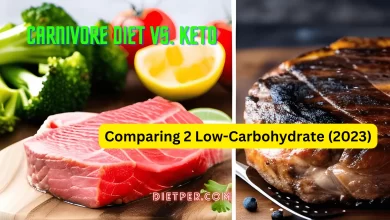The DIP Diet: Transformative Weight Management and Delicious Nutrition
Dive into the DIP DIET: A Wholesome Guide to Weight Management and Vibrant Health

The DIP DIET:- Are you on the lookout for a nutritionally sound and effective way to manage your weight while enhancing your overall well-being? Look no further than the DIP DIET! This groundbreaking approach to nutrition emphasizes the consumption of nutrient-rich foods that are not only low in calories but also high in fibre. By incorporating a variety of fruits, vegetables, whole grains, and plant-based proteins into your meals, you can significantly reduce your risk of chronic diseases, elevate your energy levels, and reach your weight loss objectives.
Table of Contents
ToggleThe Essence of the DIP DIET
In a world inundated with fad diets and instant weight-loss solutions, finding a sustainable and nourishing approach to weight management and optimal health can be a challenge. However, the DIP DIET provides a fresh perspective that prioritizes nourishing your body with wholesome foods while promoting long-term well-being.
The DIP DIET, which stands for “Diversified, Individualized, and Plant-based,” embodies a holistic nutritional approach that underscores the significance of variety, personalization, and the inclusion of plant-based foods. Rather than imposing restrictions on specific food groups, this approach encourages embracing a diverse range of whole, unprocessed foods to fuel your body and support your health goals.
Understanding the DIP DIET: Defining the Key Components
The DIP DIET is not just another fleeting diet promising quick results without lasting benefits. It is a holistic approach to weight management and overall health that centres around three core components: Discipline, Intuition, and Purpose.
Discipline forms the bedrock of the DIP DIET. It involves committing to a structured eating plan and adhering to it consistently. This means making conscious choices about the foods you consume and being mindful of portion sizes. Discipline also extends to integrating regular exercise into your routine, as physical activity is crucial for maintaining a healthy weight and promoting overall well-being.
Intuition plays a significant role in the DIP DIET. It encourages individuals to listen to their bodies and develop a deeper understanding of their own nutritional needs. Instead of relying on external rules and restrictions, the DIP DIET encourages individuals to trust their instincts and make intuitive food choices, paying attention to hunger and fullness cues, as well as recognizing how different foods make them feel.
The purpose is the driving force behind the dip diet. It involves setting clear goals and aligning your eating habits with your long-term vision of health and well-being. Whether your purpose is to lose weight, improve energy levels, or achieve optimal health, having a strong sense of purpose can provide the motivation and determination needed to stay committed to the DIP DIET.
The Role of Nutrition in Weight Management and Optimal Health
Nutrition is pivotal for weight management and overall health, supplying essential nutrients for proper bodily function. The Dip Diet advocates nourishing the body with wholesome, nutrient-dense foods, focusing on vitamins, minerals, and antioxidants while minimizing processed options. Adopting this approach involves prioritizing fresh fruits, vegetables, lean proteins, whole grains, and healthy fats, providing essential nutrients for weight management and overall well-being.
The Dip Diet additionally underscores portion control and mindful eating, encouraging an attunement to hunger and fullness cues. This practice fosters a healthier relationship with food, enabling conscious choices. Hydration is also paramount in the Dip Diet, regulating bodily functions, aiding digestion, and preventing overeating. In essence, this dietary approach offers a comprehensive strategy for optimal health and sustainable weight management.
DIP DIET Guidelines: What to Eat and What to Avoid
The DIP DIET provides a comprehensive framework for embracing a nutritious approach to weight management and achieving optimal health. To make the most out of this diet, it is crucial to understand the guidelines on what to eat and what to avoid.
Embrace Whole Foods: The foundation of the DIP DIET revolves around consuming whole, unprocessed foods. These include fruits, vegetables, whole grains, lean proteins, and healthy fats. These nutrient-dense foods provide essential vitamins, minerals, and antioxidants to support overall well-being.
Prioritize Balanced Meals:
When planning your meals, aim for a well-rounded combination of macronutrients.
Include a source of protein, such as lean meats, poultry, fish, beans, or tofu.
Incorporate complex carbohydrates like quinoa, brown rice, or sweet potatoes.
Don’t forget healthy fats like avocados, nuts, and olive oil.
Hydrate with Water: Water is the elixir of life, and it plays a vital role in the DIP DIET. Stay hydrated by drinking an adequate amount of water throughout the day. This not only helps with digestion but also promotes satiety, reducing the chances of unnecessary snacking.
Minimize Processed Foods: To embrace the dip diet truly, it is important to limit processed and packaged foods. These often contain added sugars, unhealthy fats, and artificial additives that can undermine your health goals. Opt for fresh, whole alternatives whenever possible.
Reduce Added Sugars: Sugar can wreak havoc on your health and weight management efforts. Be mindful of hidden sugars in processed foods, sodas, juices, and sweet treats. Instead, satisfy your sweet tooth with natural sources of sweetness like fruits or small quantities of honey or maple syrup.
Limit Sodium Intake: Excess sodium can contribute to bloating, water retention, and high blood pressure. Keep an eye on your sodium consumption by minimizing the use of salt and avoiding highly processed foods that are often high in sodium.
By following these DIP DIET guidelines, you can nourish your body with wholesome foods while eliminating unhealthy choices. Remember, the key to long-term success lies in consistency, moderation, and listening to your body’s needs.
The Power of Portion Control: How to Manage Serving Sizes
Mastering portion control is pivotal for maintaining a healthy weight and achieving optimal health, especially in a world of oversized meals and limitless buffet choices. Taking charge of your eating habits begins with understanding the distinction between portion size (the amount you choose to eat) and serving size (a standardized measurement recommended by nutrition experts).
Start by familiarizing yourself with common serving-size references, such as a deck of cards for meat, a tennis ball for fruit, or a hockey puck for carbohydrates. These visual cues aid in estimating appropriate portion sizes when precise measuring isn’t feasible.
Using smaller plates, bowls, and utensils is another effective strategy. Research indicates that people tend to eat less with downsized dishware, naturally promoting portion control by limiting the amount of food that fits.
Practising mindful eating enhances portion control by focusing on the eating experience—taste, texture, and satisfaction from each bite. Eating slowly allows your brain time to register fullness, preventing overeating.
Pre-portioning meals and snacks in advance is a recommended tactic. This not only curtails mindless snacking but also aids in meal planning and portion management throughout the week.
Remember, portion control is not about deprivation but finding the right balance to nourish your body without excess. With mindful awareness and practice, you can embrace the power of portion control, paving the way for a healthier, more balanced approach to eating.
Incorporating Physical Activity: Exercise and Fitness in the DIP DIET
Physical activity is a vital element of the DIP DIET, contributing not only to weight management but also overall health. Exercise offers multiple benefits, including enhanced cardiovascular health, increased muscle strength, improved endurance, elevated mood, and reduced stress levels.
When following the DIP DIET, choose activities aligning with your fitness level and enjoyment. Options like brisk walking, jogging, cycling, swimming, dancing, or group fitness classes are ideal. The key is to find sustainable activities for the long term.
To make an exercise routine, set realistic goals and create a flexible schedule. Aim for at least 150 minutes of moderate-intensity aerobic activity or 75 minutes of vigorous-intensity aerobic activity weekly, complemented by muscle-strengthening activities on two or more days.
Consistency is paramount for reaping exercise benefits. Begin gradually, increasing intensity and duration over time to prevent injuries and allow your body to adapt.
Incorporate physical activity into daily life beyond structured sessions. Opt for stairs over elevators, walk or cycle short distances, or engage in active hobbies like gardening or dancing. Prioritize rest, allowing one or two days of recovery each week for muscle repair.
Regular physical activity in your DIP DIET journey enhances weight management and brings numerous health benefits. Lace-up your sneakers, don your workout gear, and dive into the world of exercise and fitness for optimal health and well-being.
Mindful Eating: The Importance of Awareness and Emotional Well-being
Mindful eating, a key component of the DIP Diet, involves cultivating awareness and connection to the food we consume and our emotional well-being during meals. In our fast-paced lives, rushing through meals or mindless snacking can lead to overeating, poor digestion, and a disconnection from hunger signals.
Practicing mindful eating brings intention and presence to meals. Pay attention to colours, textures, and flavours, savour each bite, chew slowly, and experience the nourishment it provides.
Mindful eating extends to emotional well-being, helping distinguish between physical hunger and emotional cravings. Awareness of emotions before, during, and after eating enables conscious food choices and exploration of alternative ways to address emotional needs.
Incorporating mindfulness into eating habits nurtures both body and mind. This holistic approach supports improved weight management, enhanced digestion, and overall health and vitality.
Next mealtime, pause, breathe, and bring full attention to your plate. Embrace mindful eating for a more balanced and fulfilling relationship with food and yourself.
Meal Planning and Preparation: Tips for Success on the DIP DIET
Meal planning and preparation are crucial aspects of successfully following the dip diet. Planning your meals weekly and considering your schedule and preferences helps create a thoughtful meal plan. Make a shopping list based on nutritional needs, promoting healthier decisions and avoiding impulsive choices.
Allocate specific times for meal preparation, such as weekends. Use this time to chop vegetables, cook proteins, and ready other ingredients for the upcoming week. Consider batch cooking for time efficiency—prepare larger portions, divide them, and store them for convenient reheating during busy days.
Opt for quality food storage containers to keep meals fresh and organized. Having a well-organized system allows you to grab a pre-prepared meal whenever hunger strikes. Utilize kitchen tools like slow cookers or Instant Pots for effortless and flavorful meal preparation.
Ensure variety in your meal plan by experimenting with different recipes, flavours, and ingredients. This prevents boredom and enhances long-term adherence to the DIP DIET. Incorporating these planning and preparation tips into your routine sets the stage for success, emphasizing the importance of preparation in achieving weight management goals and optimal health.
Tracking Progress and Staying Motivated: Tools and Techniques
Tracking progress and maintaining motivation are essential components of any diet or health journey, and the DIP Diet offers various tools and techniques to support these aspects.
A food diary or tracking app is a valuable tool, allowing you to log daily meals, snacks, and drinks for a comprehensive overview of your nutritional intake. Some apps offer features like calorie counting and personalized meal plans, enhancing your progress.
Setting realistic and achievable goals is another effective technique. Break down larger health objectives into manageable milestones, celebrating each achievement. Whether it’s weight loss, clothing size reduction, or fitness milestones, acknowledging progress keeps you motivated and inspired.
Engaging with accountability partners or support groups provides invaluable encouragement. Sharing goals and progress with friends, family, or online communities offers support, advice, and shared experiences to navigate challenges.
Visual reminders, such as vision boards or mobile wallpapers, reinforce commitment by regularly presenting your goals. These reminders keep your aspirations at the forefront of your mind.
Celebrating successes is crucial. Treat yourself to non-food rewards for reaching milestones or overcoming challenges. Whether it’s a spa day, a new workout outfit, or a weekend getaway, these rewards bring joy and reinforce progress.
Utilizing these tools and techniques ensures effective progress tracking, sustained motivation, and long-term success with the DIP Diet. Remember, the journey to optimal health is about maintaining a balanced and sustainable lifestyle that supports overall well-being.
Maintaining Long-term Success: Sustaining the DIP DIET Lifestyle
Sustaining success with the DIP DIET lifestyle requires a long-term commitment, aiming not just for temporary weight loss but adopting a nourishing and sustainable approach to weight management and optimal health.
Consistency is paramount for long-term success. Adhering to DIP DIET principles consistently, including a balanced diet, regular activity, and mindful eating, ensures ongoing positive benefits.
Embrace the DIP DIET as a lasting lifestyle, integrating diverse foods, tuning into your body’s cues, and staying dedicated to the pursuit of optimal health. Establish habits that contribute to sustained success by making the dip diet an integral part of your daily life.
Regularly reassess and adjust goals to align with your evolving journey. Whether focused on weight maintenance, muscle building, or overall well-being, realistic and achievable goals foster motivation and engagement.
Incorporate flexibility into your DIP DIET lifestyle to navigate life’s dynamic challenges. While the core principles provide a solid foundation, adapt to changing circumstances, finding a balance that suits your needs.
Stay connected with a supportive community, seeking encouragement, advice, and camaraderie from friends, family, or online groups. Share experiences, learn from others, and celebrate successes together.
Regularly check in with yourself to ensure alignment with DIP DIET principles. Reflect on progress, reassess goals, and make adjustments as needed, fostering self-awareness and commitment to long-term health.
Recognize that optimal health involves holistic well-being. Prioritize self-care beyond diet and exercise, including sufficient sleep, stress management, and activities that bring joy. A well-rounded approach supports the sustainability of the DIP DIET lifestyle.
The Top 3 Diet Plans for Effective Weight Loss
By integrating these strategies and adopting the DIP DIET as a sustainable lifestyle, you can achieve and maintain long-term success in weight management and overall health. Celebrate achievements, stay committed to well-being, and relish the journey toward a healthier and more vibrant you with the DIP DIET.





